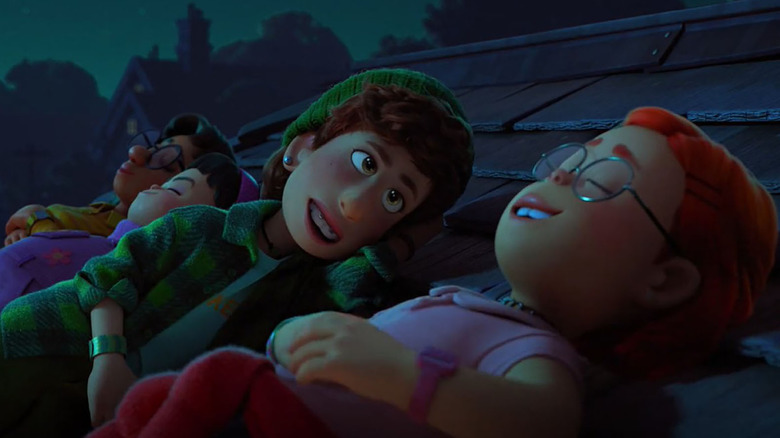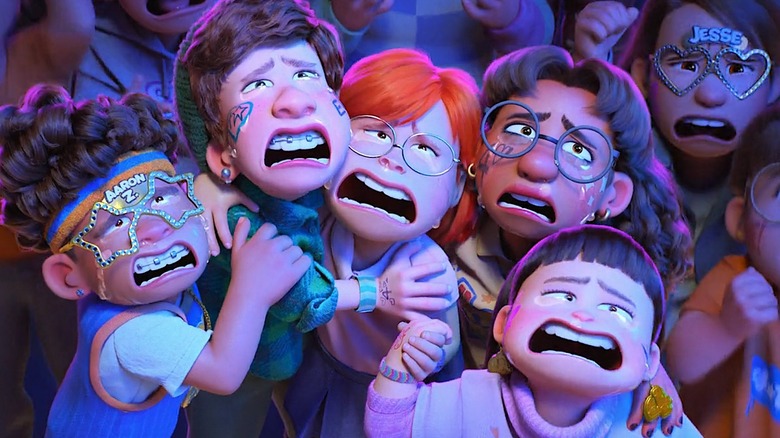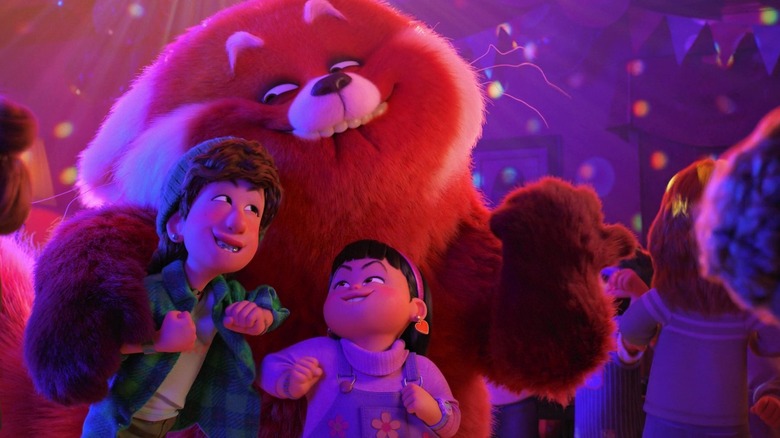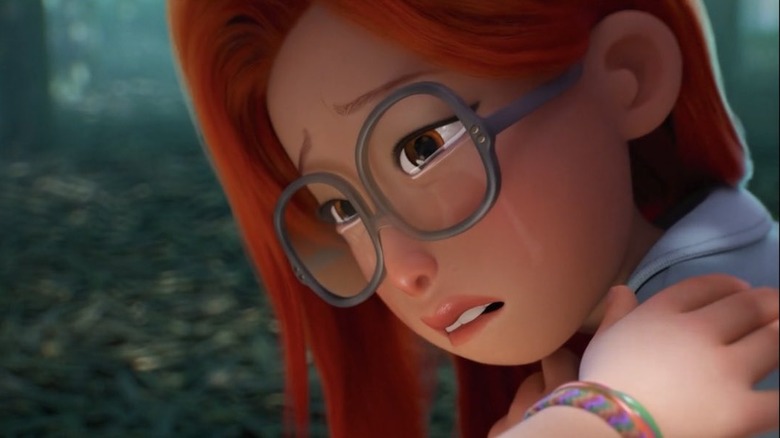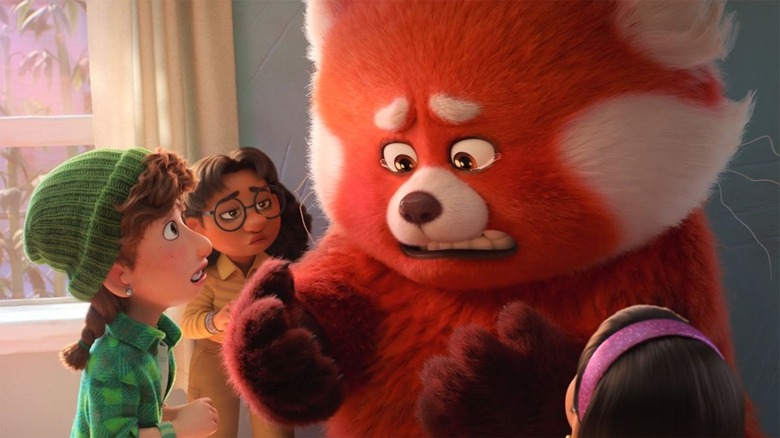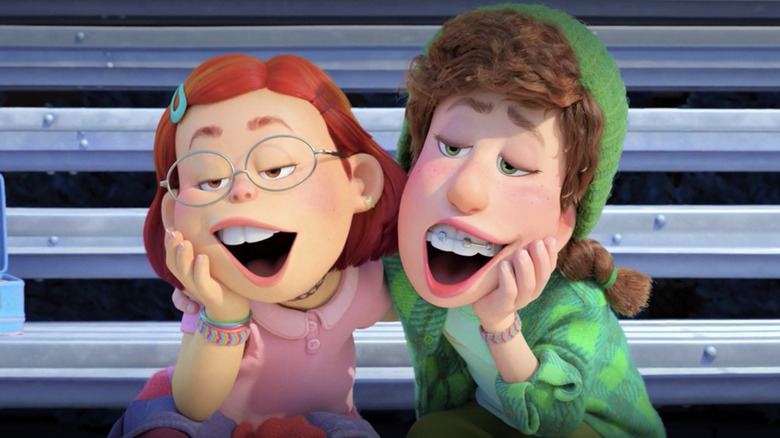Why Turning Red Is The Perfect Film To Teach Young Audiences About Queer Identity
In the wake of the controversy surrounding Disney's financial donations to the Republicans behind the passing of HB 1557, AKA the "Don't Say Gay" bill, and Disney CEO Bob Chapek's constant fumbling of the situation, the conversation regarding what is or is not appropriate to be teaching children regarding LGBTQIA+ themes has come into the public consciousness. I write a lot on /Film about children's animation or the way we culturally treat actors who got their start in children's media, because pre-pandemic, I was a social-emotional theatre educator. My entire livelihood was to teach children how to develop empathy, better understand how emotions can look on themselves and others, and use acting/writing/directing as a way to express their feelings through artistic expression. I was also an openly gay teacher, with many of my students knowing my wife is transgender — in Ohio, the Midwest's answer to Florida.
Unfortunately, Disney has a less-than-stellar history of queer coding and queer baiting while denying canonical representation in their stories. The irony of a company funding politicians who want to ban the acknowledgement of LGBTQIA+ people for elementary ages, of course being that Disney and Pixar frequently put out films that can be used as some of the best tools to educate young audiences about queer identity. The recent Pixar film "Turning Red" is littered with teachable moments that while not always explicitly about queerness, can easily be used as a jumping off point for explaining the realities of queer students they will undoubtedly meet in their classrooms. Pay attention, friends. Class is in session.
Spoilers for "Turning Red" to follow.
Start with the canonical — Tyler
When we first meet Tyler in "Turning Red," he's introduced as a secondary antagonist. He thinks Mei is a "dork narc," takes great pleasure in her humiliation, and even blackmails her into performing as the Red Panda for his birthday party. It'd be easy to see Tyler as nothing more than a school bully, but when it's revealed that Tyler is a huge fan of the band 4*Town and "loves" Aaron Z., a lot of his antics make a lot more sense. There's a common phrase that "hurt people hurt people," and it's clear that Tyler is hurting. Mei is unapologetically herself and confident in her imperfections, something that Tyler is clearly insecure about. When you're an eighth grader, sometimes those feelings of insecurity lash outward. When Tyler asks Mei to perform as the panda for his birthday, he mentions that "if you're there, everyone will come." He's afraid people won't want to celebrate his birthday unless there's a big draw other than himself.
It's at the 4*Town concert where we finally see Tyler in his element. He sings along to his favorite boy band, cries with fellow fans, and when Pandapocalypse 2002 begins, stands by his new friends to help complete the ritual. When all is said and done, Tyler is welcomed into the group with Mei, Miriam, Priya, and Abby, with Tyler even wearing his own friendship bracelet in the final scene. Tyler is a perfect conversation starter to explain the importance of allowing people to be their true selves, and how the people who aren't the nicest to us, are likely dealing with their own issues that have nothing to do with us.
Move to the thematic — embracing yourself
One of the main themes in "Turning Red" is Meilin Lee learning to embrace her panda. Mei is frequently torn between two worlds — the true nature of her identity, and the traditions of her parents. Coming out can be a really scary time for young people. What will my friends think? How is my family going to react? Will they all still love me? These are all questions that Mei worries about when she realizes she has the red panda. Queer kids are forced to ask themselves when they come to terms with their own identity. When Mei realizes that her friends still care about her, panda or not, it allows her to have the security and stability of a found family.
An unfortunate reality is that many queer kids are disowned for being queer and must seek out their own found families. Those friendships and connections are just as valid despite a lack of blood relation. The very thing that helps Mei learn to keep her panda in control, is not the love of her family, but the love of her friend group — her found family. While it's highly unlikely that any of the young audiences watching this movie are going to have a classmate faced with having to choose between keeping their spiritual red panda or not, there is a high probability that they will have classmates who will struggle with whether or not to tell their family the truth of their identity. Using Mei and her friends as an example, this movie can be extremely beneficial in teaching children why it is important to care about your friends and not judge them for things they cannot control.
Theming — queer kids often teach their parents
From a very young age, children are taught to respect, listen, and learn from their parents. These are the people who teach us how to tie our shoes and eat solid food. It makes complete sense why a child would think that their parents are the authority on all topics. However, when it comes to queer youth, these children often have to act as educators for their parents. We do not teach people about queer identity, and our media certainly has a long way to go before there is a universal understanding of the hardships and difficulties that queer people face. Mei is forced into the teacher role for her own mother when it comes to the red panda, as Mei is the first in a long history of women to actually embrace the gift of her ancestors, instead of locking it away. When all of the women in Mei's family are in the panda dimension forest, it is Mei who seeks out her mother and offers her sage advice. It is Mei who holds her mother's hand and takes her back to the circle to the real world.
Mei is teaching her mother that she is going to be okay, even if her mother is scared for her. These are very similar conversations that a lot of queer kids have to have with their own parents. Too often, parents assume that their children are not ready to make such big decisions about their lives, and they are afraid that the world is going to be hard on them because of their differences. But children know who they are when it comes to something like their identity, they and they know themselves better than their parents ever will. It is okay for parents to take the lead from their children, and it is okay for children to learn that their friends may have a better idea about their own identity than their parents do.
The allegorical — red pandas as dysphoria
The beautiful thing about "Turning Red" and the allegory of Mei's red panda, is that it can serve as a metaphor for a variety of teenage issues. Menstruation, puberty, and the ever changing growing pains of life are easily validated by Mei's red panda turning her into a "gross, red monster," as she says, but can also be used as an allegory for body and gender dysphoria. When Mei first sees herself as the panda, she is initially horrified at the sudden changes of body hair, a roaring voice, and a change in size. While these puberty changes are common for all children, they can be especially difficult for trans children whose puberties cause changes in ways that further alienate them from their own body.
Mei tries to hide her changes by wearing a large woolen hat, fully buttoned up shirts, and loses the range of her emotional expressions to keep the panda at bay. Trans youth are frequently made to feel smaller, erased, and forced to push their truth into submission, something Mei is forced to do with her panda. It is only when she learns to embrace the truth from inside her that she is finally able to find true and universal joy. This allegory is a perfect way to start a conversation with young viewers on how to explain how their gender non-conforming students might be feeling, and to motivate them to be like Miriam, Priya, and Abby, and love their friends no matter what changes they may be going through.
The coded — Miriam
We learn that the major fight that occurred between Mei's mom Ming and her own mother was centered on Ming's love of Jin (Mei's dad), an immediate parallel can be drawn to Ming's disapproval of Miriam. While Mei clearly has a solid friend group, Miriam is posed as being the closest and truest B.F.F. that Mei has. The most obvious reading of this situation is allowing the romantic relationship of Ming and Jin and the friendship of Mei and Miriam to carry the same weight of importance, but there is a possible coding at play that Miriam's feelings for Mei are perhaps a bit deeper. Miriam is presented with "tomboy" fashion and there are frequent references from Ming as to her thinking Miriam is a bad influence. Does Ming know something about Miriam that we don't? Because every moment we see of Miriam is her being a strong, supportive, loyal friend.
This is a great moment to explain to children that sometimes there are different meanings and interpretations that can be made when hearing a story. We can see their friendship and view it as purely platonic, or it can be viewed as two teenagers trying to figure out if the dynamics of their friendship actually mean something more. Did Miriam take care of the Tamagotchi because she cares about her best friend, or are Miriam's feelings stronger than friendship? While Miriam is shown as being interested in boys, we know that compulsory heterosexuality is a thing, so this coding to allows children to look at a different interpretation of her character. Not only does introducing the concept of coded characters help children with their media literacy, it also allows them to learn that sometimes it's good to question if there is more than what meets the eye.
Class is dismissed!
